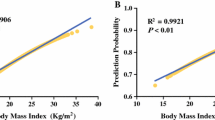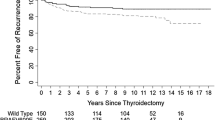Abstract
Current evidences suggest an influence of overweight body mass index (BMI) on the carcinogenesis in malignancies. However, the role of BMI is unclear in papillary thyroid cancer (PTC). The aim of the present study is to investigate the relationship between BMI and BRAF V600E mutation status in PTC. BRAF V600E mutation in 108 patients with PTC was analyzed by Sanger sequencing. The cutoff point of BMI was identified by X-tile for predicting mutation by overweight. Odds ratios (OR) and 95 % confidence interval (CI) of BRAF V600E mutation according to BMI and clinicopathologic variables were calculated using logistic regression models. Fifty-one patients were positive for BRAF V600E mutation. A positive relationship existed between BRAF V600E mutation and BMI (p = 0.039). A 24.3 kg/m2 was identified as cutoff point for differentiating greater than 52.0 % observed probability of mutation for BRAF V600E in entire cohort, which was similar to the midpoint between the upper limit of normal BMI and overweight defined by WHO (≥24 kg/m2). Multivariate analysis confirmed the association between BRAF V600E mutation with overweight BMI range (OR 7.645, 95 % CI 1.275–45.831, p = 0.026). This study suggests an influence of overweight BMI on the status of BRAF V600E in patients with PTC, whereas the underlying mechanism need to be further investigated.


Similar content being viewed by others
References
James FR, Wootton S, Jackson A, Wiseman M, Copson ER, Cutress RI. Obesity in breast cancer—what is the risk factor? Eur J Cancer. 2015;51:705–20.
Scarpa M, Ruffolo C, Erroi F, Fiorot A, Basato S, Pozza A, et al. Obesity is a risk factor for multifocal disease and recurrence after colorectal cancer surgery: a case–control study. Anticancer Res. 2014;34:5735–41.
Ortiz-Mendoza CM, Velasco-Navarro C. [Obesity, a main risk factor for endometrial cancer]. Rev Med Inst Mex Seguro Soc. 2013;51:260–3.
Han JM, Kim TY, Jeon MJ, Yim JH, Kim WG, Song DE, et al. Obesity is a risk factor for thyroid cancer in a large, ultrasonographically screened population. Eur J Endocrinol. 2013;168:879–86.
Anderson AS, Key TJ, Norat T, Scoccianti C, Cecchini M, Berrino F, et al. European code against cancer 4th edition: obesity, body fatness and cancer. Cancer Epidemiol. 2015;39 Suppl 1:S34–45.
Gathirua-Mwangi WG, Zollinger TW, Murage MJ, Pradhan KR, Champion VL. Adult BMI change and risk of breast cancer: national health and nutrition examination survey (NHANES) 2005–2010. Breast Cancer. 2015;22:648–56.
Hursting SD, Nunez NP, Patel AC, Perkins SN, Lubet RA, Barrett JC. The utility of genetically altered mouse models for nutrition and cancer chemoprevention research. Mutat Res. 2005;576:80–92.
Azvolinsky A. Cancer prognosis: role of BMI and fat tissue. J Natl Cancer Inst. 2014;106:dju177.
Xing M, Westra WH, Tufano RP, Cohen Y, Rosenbaum E, Rhoden KJ, et al. BRAF mutation predicts a poorer clinical prognosis for papillary thyroid cancer. J Clin Endocrinol Metab. 2005;90:6373–9.
Xing M. BRAF mutation in papillary thyroid cancer: pathogenic role, molecular bases, and clinical implications. Endocr Rev. 2007;28:742–62.
Benvenuti S, Sartore-Bianchi A, Di Nicolantonio F, Zanon C, Moroni M, Veronese S, et al. Oncogenic activation of the ras/raf signaling pathway impairs the response of metastatic colorectal cancers to anti-epidermal growth factor receptor antibody therapies. Cancer Res. 2007;67:2643–8.
Sobin LHGM, Wittekind CH, UICC. TNM classification of malignant tumors. 7th ed. New York: Wiley-Liss; 2009.
Edge SB, Compton CC. The American Joint Committee on Cancer: the 7th edition of the AJCC cancer staging manual and the future of TNM. Ann Surg Oncol. 2010;17:1471–4.
Richter A, Grieu F, Carrello A, Amanuel B, Namdarian K, Rynska A, et al. A multisite blinded study for the detection of braf mutations in formalin-fixed, paraffin-embedded malignant melanoma. Sci Rep. 2013;3:1659.
Campbell PT, Newton CC, Newcomb PA, Phipps AI, Ahnen DJ, Baron JA, Buchanan DD, Casey G, Cleary SP, Cotterchio M, Farris AB, Figueiredo JC, Gallinger S, Green RC, Haile RW, Hopper JL, Jenkins MA, Le Marchand L, Makar KW, McLaughlin JR, Potter JD, Renehan AG, Sinicrope FA, Thibodeau SN, Ulrich CM, Win AK, Lindor NM, Limburg PJ: Association between body mass index and mortality for colorectal cancer survivors: Overall and by tumor molecular phenotype. Cancer epidemiology, biomarkers & prevention : a publication of the American Association for Cancer Research, cosponsored by the American Society of Preventive Oncology 2015.
Brandstedt J, Wangefjord S, Nodin B, Eberhard J, Sundstrom M, Manjer J, et al. Associations of anthropometric factors with KRAS and BRAF mutation status of primary colorectal cancer in men and women: a cohort study. PLoS ONE. 2014;9, e98964.
Hughes LA, Williamson EJ, van Engeland M, Jenkins MA, Giles GG, Hopper JL, et al. Body size and risk for colorectal cancers showing braf mutations or microsatellite instability: a pooled analysis. Int J Epidemiol. 2012;41:1060–72.
Kim B, Park SJ, Cheon JH, Kim TI, Kim WH, Hong SP. Clinical meaning of braf mutation in Korean patients with advanced colorectal cancer. World J Gastroenterol. 2014;20:4370–6.
Slattery ML, Curtin K, Sweeney C, Levin TR, Potter J, Wolff RK, et al. Diet and lifestyle factor associations with cpg island methylator phenotype and BRAF mutations in colon cancer. Int J Cancer. 2007;120:656–63.
Zhang W, Bai X, Ge H, Cui H, Wei Z, Han G. Meta-analysis in the association between obesity and risk of thyroid cancer. Int J Clin Exp Med. 2014;7:5268–74.
Hou P, Liu D, Xing M. Genome-wide alterations in gene methylation by the BRAF V600E mutation in papillary thyroid cancer cells. Endocr Relat Cancer. 2011;18:687–97.
Xing M, Alzahrani AS, Carson KA, Shong YK, Kim TY, Viola D, et al. Association between BRAF V600E mutation and recurrence of papillary thyroid cancer. J Clin Oncol. 2015;33:42–50.
Xing M, Alzahrani AS, Carson KA, Viola D, Elisei R, Bendlova B, et al. Association between BRAF V600E mutation and mortality in patients with papillary thyroid cancer. JAMA. 2013;309:1493–501.
Xing M. BRAF V600E mutation and papillary thyroid cancer. JAMA. 2013;310:535.
Xing M. BRAF mutation in papillary thyroid microcarcinoma: the promise of better risk management. Ann Surg Oncol. 2009;16:801–3.
Guan H, Ji M, Bao R, Yu H, Wang Y, Hou P, et al. Association of high iodine intake with the T1799A BRAF mutation in papillary thyroid cancer. J Clin Endocrinol Metab. 2009;94:1612–7.
Wang Y, Ji M, Wang W, Miao Z, Hou P, Chen X, et al. Association of the T1799A BRAF mutation with tumor extrathyroidal invasion, higher peripheral platelet counts, and over-expression of platelet-derived growth factor-B in papillary thyroid cancer. Endocr Relat Cancer. 2008;15:183–90.
Guan H, Ji M, Hou P, Liu Z, Wang C, Shan Z, et al. Hypermethylation of the DNA mismatch repair gene hmlh1 and its association with lymph node metastasis and T1799A BRAF mutation in patients with papillary thyroid cancer. Cancer. 2008;113:247–55.
Liu D, Hu S, Hou P, Jiang D, Condouris S, Xing M. Suppression of BRAF/MEK/MAP kinase pathway restores expression of iodide-metabolizing genes in thyroid cells expressing the V600E BRAF mutant. Clin Cancer Res. 2007;13:1341–9.
Eveleth PB, Andres R, Chumlea WC, Eiben O, Ge K, Harris T, et al. Uses and interpretation of anthropometry in the elderly for the assessment of physical status. Report to the nutrition unit of the world health organization: the expert subcommittee on the use and interpretation of anthropometry in the elderly. J Nutr Health Aging. 1998;2:5–17.
Joensuu K, Hagstrom J, Leidenius M, Haglund C, Andersson LC, Sariola H, et al. Bmi-1, c-myc, and Snail expression in primary breast cancers and their metastases—elevated bmi-1 expression in late breast cancer relapses. Virchows Arch. 2011;459:31–9.
Faruk Aykan N, Yildiz I, Sen F, Kilic L, Keskin S, Ciftci R, et al. Effect of increased body mass index (BMI) on time to tumour progression (TTP) in unresectable metastatic colorectal cancer (MCRC) patients treated with bevacizumab-based therapy. Med Oncol. 2013;30:679.
Wolin KY, Carson K, Colditz GA. Obesity and cancer. Oncologist. 2010;15:556–65.
Halnan KE. Influence of age and sex on incidence and prognosis of thyroid cancer. Three hundred forty-four cases followed for ten years. Cancer. 1966;19:1534–6.
Moreira Leite KR, de Araujo VC, Rezende Meirelles MI, Lopes Costa AD, Camara-Lopes LH. No relationship between proliferative activity and the macis prognostic scoring system in papillary thyroid carcinoma. Head Neck. 1999;21:602–5.
Rodriguez-Cuevas S, Labastida-Almendaro S, Cortes-Arroyo H, Lopez-Garza J, Barroso-Bravo S. Multifactorial analysis of survival and recurrences in differentiated thyroid cancer. Comparative evaluation of usefulness of ages, macis, and risk group scores in Mexican population. J Exp Clin Cancer Res. 2002;21:79–86.
Nikiforova MN, Kimura ET, Gandhi M, Biddinger PW, Knauf JA, Basolo F, et al. BRAF mutations in thyroid tumors are restricted to papillary carcinomas and anaplastic or poorly differentiated carcinomas arising from papillary carcinomas. J Clin Endocrinol Metab. 2003;88:5399–404.
Kebebew E, Weng J, Bauer J, Ranvier G, Clark OH, Duh QY, et al. The prevalence and prognostic value of braf mutation in thyroid cancer. Ann Surg. 2007;246:466–70. discussion 470–461.
Hayes A, Gearon E, Backholer K, Bauman A, Peeters A. Age-specific changes in BMI and BMI distribution among Australian adults using cross-sectional surveys from 1980 to 2008. Int J Obes (Lond). 2015;39:1209–16.
Knauf JA, Ma X, Smith EP, Zhang L, Mitsutake N, Liao XH, et al. Targeted expression of BRAFV600E in thyroid cells of transgenic mice results in papillary thyroid cancers that undergo dedifferentiation. Cancer Res. 2005;65:4238–45.
Xing M. Molecular pathogenesis and mechanisms of thyroid cancer. Nat Rev Cancer. 2013;13:184–99.
Acknowledgments
This work was supported by funds from the National Science Foundation of China (No. 81572622 and No. 81272934 to QHJ), the Shanghai Rising-Star Program (No. 15QA1401100 to YLW), and the Project Sponsored by the Scientific Research Foundation for the Returned Overseas Chinese Scholars, State Education Ministry (to TL).
Author information
Authors and Affiliations
Corresponding authors
Ethics declarations
Written informed consent from all the patients was provided. This study was approved by the Ethical Committee of the Shanghai Cancer Center of Fudan University.
Conflicts of interest
None
Additional information
Rong-liang Shi, Ning Qu and Tian Liao contributed equally to this work.
Rights and permissions
About this article
Cite this article
Shi, Rl., Qu, N., Liao, T. et al. Relationship of body mass index with BRAF V600E mutation in papillary thyroid cancer. Tumor Biol. 37, 8383–8390 (2016). https://doi.org/10.1007/s13277-015-4718-y
Received:
Accepted:
Published:
Issue Date:
DOI: https://doi.org/10.1007/s13277-015-4718-y




